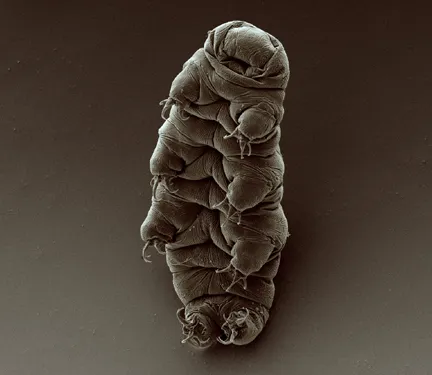Water Bears Just Don't Care

An Adult Water Bear
In 1773, German zoologist Johann August Ephraim Goeze peered through his compound microscope and gazed upon a tiny, eight-legged creature he dubbed a “little water bear”. Cute, huh? The scientific name for these itty-bitty varmints is “tardigrade”, but there’s another nickname for them I like better – moss piglet. Can you believe it? I mean, look at that thing. Moss piglet! That’s perfect. I can almost hear it oinking.
OK, so what the heck is a water bear/tardigrade/moss piglet anyway? It’s not a bear and it’s not a pig, but it is an animal. It’s an extremely tiny animal, but it’s an animal, nonetheless. Your average tardigrade measures about two one-hundredths of an inch in length. They eat plant cells, algae and small invertebrates unfortunate enough to pass by their way. There are over one thousand different varieties of them, and they live pretty much everywhere. That’s right – everywhere. They prefer wet places, or at least areas of high moisture, but they are extremely tough and can live in places where humans would die instantly. Plunk them down anywhere. Water bears just don’t care.
Heat? They can survive temperatures in excess of 300 degrees Fahrenheit.
Cold? Water bears can get by just fine at -320 degrees Fahrenheit.
Radiation? No sweat.
Boiling liquids? The moss piglet squeals with laughter.
Deep ocean pressures? Not a problem.
The open vacuum of space? Piece of cake. They actually can survive in outer space. Scientist have tested them in orbit for periods of up to ten days without any protection at all and they shrugged it off like it was a walk in the park.
These are tough little piggies to be sure. Their weirdly cute appearance as velvety, plump caterpillars with stubby legs and little wiry claws really begs for our attention. Scientists have been studying them since the profusely named Johann August Ephraim Goeze first drew a picture of one. I can only imagine what it must have been like for Goeze when he was first showing that early drawing around. His wife was a lady named Leopoldine Maria Keller. I have no idea whether or not Goeze gave his wife any nicknames, but I’m going to pluck the “pol” out of the middle of her first name and call her “Polly.” Here’s how I picture that day in 1773 going down at the Goeze house.
“Polly! Polly!” Johann exclaimed, running in through the front door, a wrinkled piece of parchment flapping wildly in his gesticulating hand.
“What now?” answered a tepid Polly. She had seen her share of uninteresting squiggly lines and amorphous blobs over the years.
“It’s a bear!”
“A bear? Really, Johann? A bear? You’ve been leaning too far over the formaldehyde barrel again, haven’t you?”
“Well, no. It’s not a real bear. It’s a little water bear – teeny, in fact. Look at this picture. I saw it with my microscope today while looking at some water samples from the bog. It was there among the moss fragments, just floating along, waving its little arms.” Johann held up the annotated pen and ink drawing, his hand quivering with glee. “See?” he asked. “Doesn’t it look like a bear?”
“No, Johann. It looks like a figment of your overactive imagination. A figment – or maybe a piglet.” Polly then began to laugh uncontrollably at the invention of her new moniker for the tardigrade. “You found it among the moss. Call it a moss piglet.” Staggering under the effects of her laughter, Polly left to go lie down and recover on the divan in the parlor. Johann remained behind, dejectedly and fondly looking at his drawing of the little water bear.
“It’s not a pig,” Johann muttered to himself, but he couldn’t help smiling.
OK, so there’s pretty much no way that’s how it happened. I was just having a bit of imaginative fun, but it was a strange discovery, so it likely stirred some lively conversation in the real version of the story. Today, scientists are still trying to learn about these unusual animals to find out why they are so resilient. There could be discoveries made from studying the tardigrade that could lead to medical advancements or ways for humans to deal with and work in harsh environments. There are a lot of articles, photos, and even movies out there on the web dealing with the bizarre moss piglet. Set an hour or so aside and do some digging. You will be amazed at what a big deal this tiny creature really is.
This article was written by Tilmer Wright, Jr. Tilmer is an IT professional with over thirty years of experience wrestling with technology and a proud member of the Authors Guild of Tennessee. In his spare time, he writes books. His second novel, The Bit Dance is a cautionary tale about what can happen when technology runs away from its creators. You can find links to Tilmer’s books at the following location: https://www.amazon.com/Tilmer-Wright/e/B00DVKGG4K%3Fref=dbs_a_mng_rwt_s…
His author information web site is here: http://www.tilmerwrightjr.com/
The picture of the adult tardigrade was taken by Goldstein Lab and can be found on their Flikr page here: https://www.flickr.com/photos/11562437@N03
The picture is used under the Creative Commons Share-Alike 2.0 Generic license. The license may be found at the following link. No changes were made to the image.
https://creativecommons.org/licenses/by-sa/2.0/deed.en
- Log in to post comments